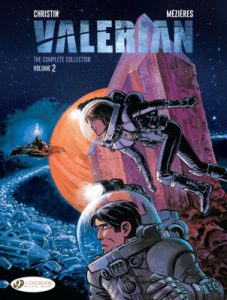Looking for a “Valerian” fix after last year’s movie, “Valerian and the City of a Thousand Planets,” I’m delving into the comics that started it all, by Frenchmen Pierre Christin (writer) and Jean-Claude Mezieres (pencils and inks). “The Complete Collection, Volume 2” includes “The Land Without Stars” (1972), “Welcome to Alflolol” (1972) and “Birds of the Master” (1973).
Volume 3: “The Land Without Stars” (1972)
I don’t know if this fourth “Valerian” story was prescient or if it’s a coincidence, but the year before tennis’ Battle of the Sexes, Christin and Mezieres staged a larger battle of the sexes in the hollow core of a planet. That immediately calls to mind Jules Verne’s 19th century classic “Journey to the Center of the Earth,” but that’s where the similarities end. For one, Valerian and Laureline – in their still-unnamed ship, known as the Intruder in the movie – enter the hollow planet through a membrane.
Inside, they find a perpetual war between a matriarchal tribe and a patriarchal tribe, along with a third group that provides weapons to both sides. While the notion of a world of perpetual war has been more buzzworthy in the post-9/11 era, Christin was very much tapped into Eisenhower’s 1961 observation of the military-industrial complex (which the U.S. prez ironically helped to propagate).
That’s an on-point theme to balance out a story with crazier “physics” than even Verne could dream up. Inside this hollow planet is a sun and a moon. The weapons producers travel in the moon’s cool shadow as nomads, with a large creature carrying their buildings on their backs. I’m reminded of a couple “Star Wars” works: Lando’s Nkklon mining facility in “Heir to the Empire” and the moving city in “The Approaching Storm.”
The most iconic “Star Wars”-ian imagery, though, is Laureline’s metal bikini, a precursor to Leia’s in “Return of the Jedi.” She is the servant of the king of the male tribe, and she ends up unwittingly fighting Valerian, a slave warrior for the female tribe. When V&L apprehend the leaders of each side and show them the stars for the first time, it’s like what Superman hopes to achieve in “Superman IV: The Quest for Peace”: The warring nations change their ways upon seeing the insignificance of their planet against the backdrop of the cosmos. And in a parallel to the first “Superman” movie, V&L circle the planet in their space-time ship, changing its trajectory enough to change its fate: It’s no longer on a collision course with Terran colony worlds.
4.5 stars
Volume 4: “Welcome to Alflolol” (1972)
Remaining as wildly fun as the previous adventures, this fifth installment also boasts the most focused themes and for the first time adds significant conflict between Valerian and Laureline. To this point, they had been portrayed as a cutely bickering and flirting couple. (Or should-be couple; frankly it’s hard to tell. Neither proposes a DTR – Define The Relationship – talk, like the movie’s Valerian does.)

But Valerian’s tendency to follow orders and Laureline’s tendency to question them comes into conflict when the human government of the Terran colony Technorog sends the natives (who call the planet Alflolol) to a reservation. Laureline shuns Valerian until he comes to her side. Besson’s 2017 film highlighted the contrast between these two points of view in a climactic scene, but “Alflolol” teases it out over the course of the whole story, making it quite satisfying when our hero does the right thing and Laureline exclaims “I’ve got my Valerian back!”
The Native American parallel is obvious, yet Christin and Mezieres keep things lively. The Alflolol natives don’t know the meaning of industrial-age work; they are more than content with their hunter-gatherer lifestyle. Indeed, their parties can last for days. The Technorog governor, meanwhile, is a parody of such a character. Ultimately, the story has a Pollyanna ending, as the guv agrees that the land should be returned to the natives, as per “the Galactic Code” (as if Earth governments take their own codes seriously), but C&M have earned enough goodwill by this point that I’ll allow it.
5 stars
Volume 5: “Birds of the Master” (1973)
The sixth story is a slight step down because it’s rather gloomy, although the theme is again focused: V&L crash amid a spaceship junkyard on a planet ruled by a mysterious “Master.” Thrown in with the slaves of various alien races, they are exposed to a variety of points of view, from those who love working for the Master, to those who can’t fathom another reality, to those who want to rebel. The latter group is widely seen as crazy, but V&L organize them and lead a rebellion, very much like Luke and company often did in the original Marvel “Star Wars” comics. It’s nice to see V&L on the same page here, although by that same token, “Birds of the Master” lacks the relationship tension of “Alflolol.”
The yarn naturally has page-turning intrigue as we await what I thought would be a “Wizard of Oz”-style reveal of the man behind the curtain. However, the Master is a legitimately scary gigantic blob creature that can fill people’s minds with despair – the “Star Wars” novel “The Crystal Star” had a similar thought-blob named Waru.
After freedom is won and the natives form a voluntary commune, Laureline – who again ends up in a skimpy battle costume (gee, I wonder if young males were the comic’s target audience?) – wisely notes that she and her partner will probably encounter many more societies like that of the Master: “Since his power comes from others’ resignation, he won’t have any trouble finding places where they like authority!”
“V&L” endings haven’t been memorable so far, but “Birds of the Master” closes with a killer final panel where we pan out and see the Master attached to the ship. We’ll have to wait till the next tale to learn if this is just a fun clincher, or if it’s a “to be continued” cliffhanger. (I’m guessing the former.)
4 stars
Click here for a complete index of “Valerian and Laureline” reviews.

